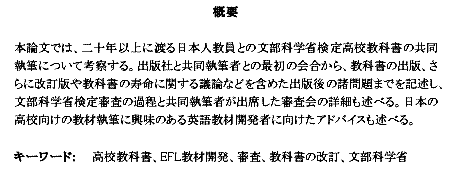|
Abstract
This paper describes the process of co-authoring a series of Japanese Ministry of Education, Culture, Sports, Science and Technology (MEXT)-authorized
high school textbooks with a group of EFL teachers in Japan over a period of twenty years. The process described runs from the first meeting between
the publishers and the co-authors, through publication of the textbook, to post-publication issues, including subsequent revised editions and discussions
about the lifespan of a textbook. The MEXT screening process is explained and details are given of the co-authors' appearances before the screening panel.
Advice is given for materials writers interested in writing textbooks for the Japanese high school market.
|
Keywords:
high school textbooks, EFL textbook development, textbook screening, educational textbook revision, MEXT

|
